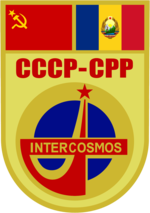Soyuz 40
| Mission emblem | |||
|---|---|---|---|

|
|||
| Mission dates | |||
| Mission: | Soyuz 40 | ||
| COSPAR-ID : | 1981-042A | ||
| Spacecraft: |
Soyuz 7K-T ( GRAY index 11F615A8) serial number 56 |
||
| Dimensions: | 6800 kg | ||
| Launcher: | Soyuz U (GRAY index 11A511U) | ||
| Call sign: | Днепр (" Dnepr ") | ||
| Crew: | 2 | ||
| Begin: | May 14, 1981, 17:16:38 UTC | ||
| Starting place: | Baikonur 1/5 | ||
| Space station: | Salyut 6 | ||
| Coupling: | May 15, 1981, 18:50 UTC | ||
| Decoupling: | May 22, 1981, 10:37 UTC | ||
| Landing: | May 22, 1981, 13:58:30 UTC | ||
| Landing place: | 225 km southeast of Djeskazgan | ||
| Flight duration: | 7d 20h 41m 52s | ||
| Earth orbits: | 124 | ||
| Rotation time : | 89.1 (91.2) min | ||
| Apogee : | 287 (362) km | ||
| Perigee : | 198 (333) km | ||
| Team photo | |||
 Leonid Popov and Dumitru Prunariu |
|||
| ◄ Before / After ► | |||
|
|||
Soyuz 40 is the mission name for the flight of a Soviet Soyuz spacecraft to the Soviet space station Salyut 6, which started on May 14, 1981 . It was the 17th visit by a manned Soyuz spacecraft to this space station and the 64th flight in the Soviet Soyuz program.
crew
Main crew
- Leonid Ivanovich Popov (2nd space flight), commander
-
Dumitru Dorin Prunariu (1st space flight), flight engineer ( Romania )

Popov had only returned from a six-month stay on board Salyut 6 seven months earlier .
Substitute team
- Yuri Viktorovich Romanenko , commandant
-
Dumitru Dediu , flight engineer ( Romania )

Mission overview
Soyuz 40 brought the ninth Interkosmos crew (also the tenth visiting crew, Salyut 6 EP-10) to the Salyut 6 space station. There they visited the 6th regular team (Salyut 6 EO-6) Vladimir Kovaljonok and Viktor Savinych , who were with Soyuz T-4 started.
Soyuz 40 was the last spaceship to dock with Salyut 6 and at the same time the end of the first phase of the manned Interkosmos program. The Romanian Prunariu mainly observed the earth's magnetic field . The scheduled earth observations were postponed until the last opportunity to fly over Romania on the last day. At this point, the team also tested the station's orientation system.
With this flight, the use of the spacecraft type 7K-T , which was replaced by the now tried and tested Soyuz T (7K-ST) , also ended.
See also
Web links
- Soyuz 40 at spacefacts.de
- Soyuz 40 at space.kursknet.ru (English / Russian , archived 2016)
- Sojus 40 in the Encyclopedia Astronautica (English)
- Soyuz 40 in the NSSDCA Master Catalog (English)
